Leadership, Management, and Operations in the Context of Tesco
VerifiedAdded on 2022/12/26
|12
|4079
|24
Report
AI Summary
This report offers a comprehensive analysis of leadership and management practices within Tesco, a multinational retail organization. It begins by defining and comparing the distinct roles and characteristics of leaders and managers, illustrating these concepts with examples from Tesco's operations. The report explores situational leadership, systems leadership, and contingency theories, demonstrating their practical application. Furthermore, it delves into key approaches to operations management, such as Total Quality Management, Lean Manufacturing, and Just-in-Time systems, examining the roles that leaders and managers play in each approach. The report assesses the impact of the business environment on operational management and decision-making, providing a well-rounded perspective on Tesco's strategies and practices. The report concludes with recommendations for further improvement, based on the analysis provided.
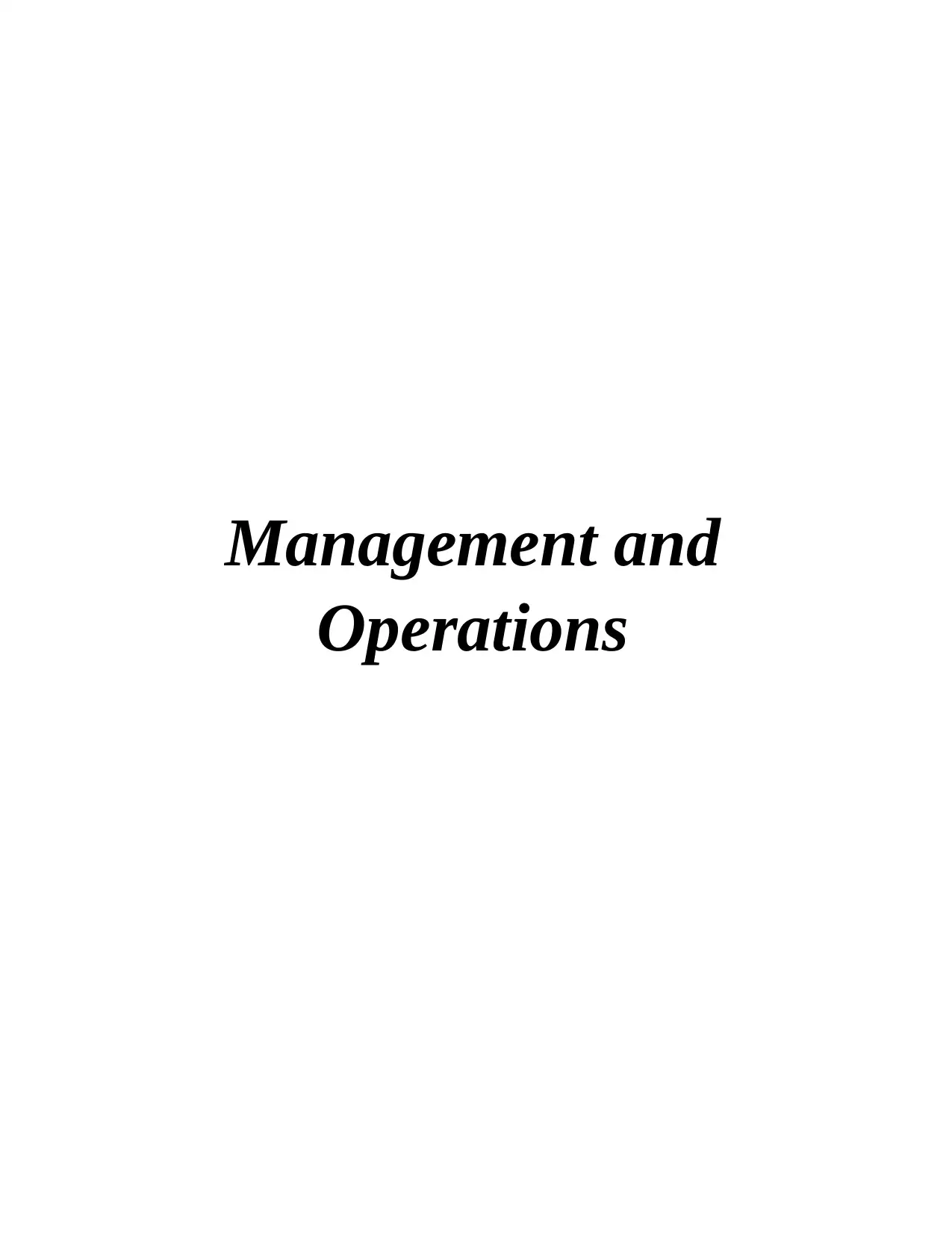
Management and
Operations
Operations
Paraphrase This Document
Need a fresh take? Get an instant paraphrase of this document with our AI Paraphraser
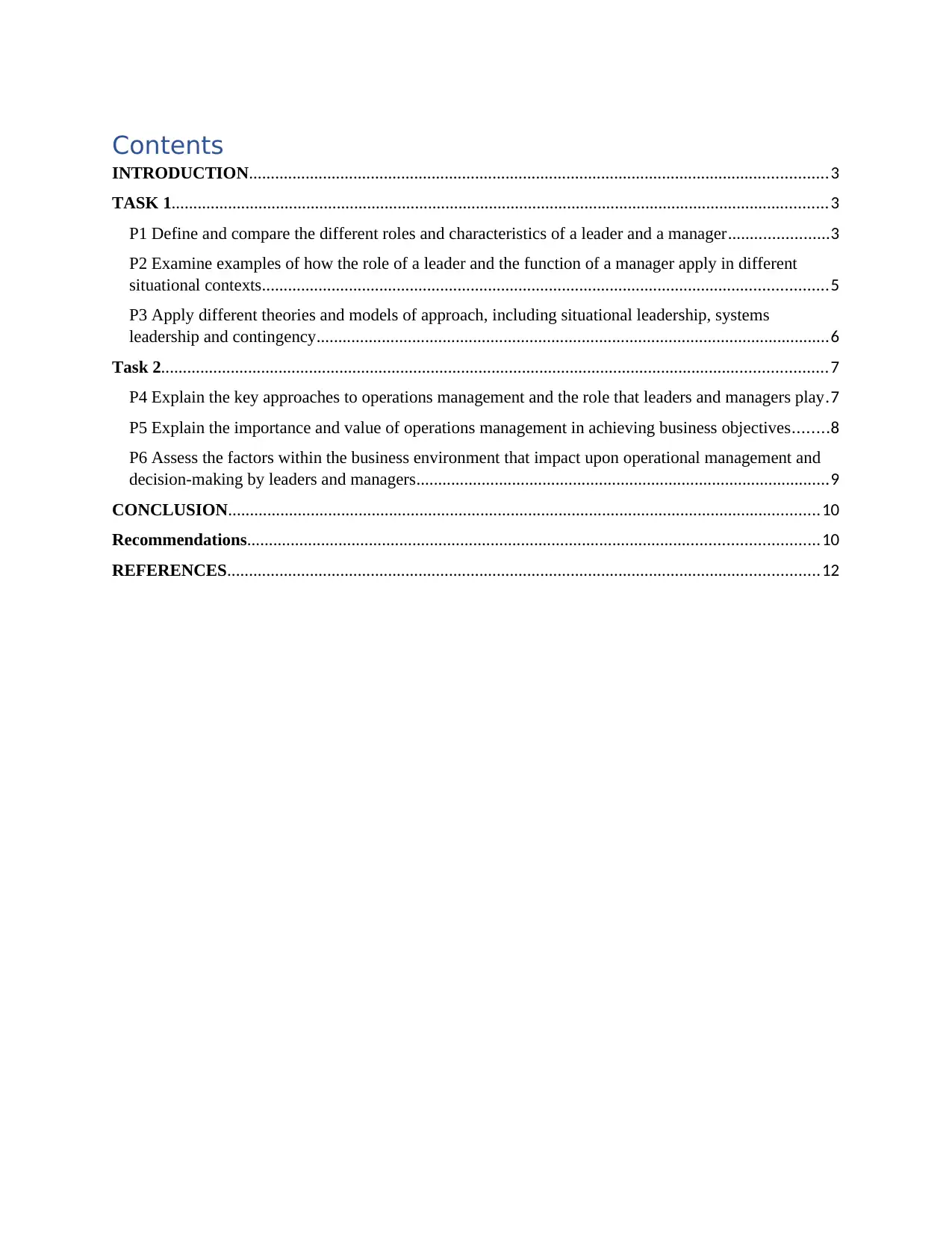
Contents
INTRODUCTION.....................................................................................................................................3
TASK 1.......................................................................................................................................................3
P1 Define and compare the different roles and characteristics of a leader and a manager.......................3
P2 Examine examples of how the role of a leader and the function of a manager apply in different
situational contexts..................................................................................................................................5
P3 Apply different theories and models of approach, including situational leadership, systems
leadership and contingency......................................................................................................................6
Task 2.........................................................................................................................................................7
P4 Explain the key approaches to operations management and the role that leaders and managers play.7
P5 Explain the importance and value of operations management in achieving business objectives........8
P6 Assess the factors within the business environment that impact upon operational management and
decision-making by leaders and managers...............................................................................................9
CONCLUSION........................................................................................................................................10
Recommendations...................................................................................................................................10
REFERENCES........................................................................................................................................12
INTRODUCTION.....................................................................................................................................3
TASK 1.......................................................................................................................................................3
P1 Define and compare the different roles and characteristics of a leader and a manager.......................3
P2 Examine examples of how the role of a leader and the function of a manager apply in different
situational contexts..................................................................................................................................5
P3 Apply different theories and models of approach, including situational leadership, systems
leadership and contingency......................................................................................................................6
Task 2.........................................................................................................................................................7
P4 Explain the key approaches to operations management and the role that leaders and managers play.7
P5 Explain the importance and value of operations management in achieving business objectives........8
P6 Assess the factors within the business environment that impact upon operational management and
decision-making by leaders and managers...............................................................................................9
CONCLUSION........................................................................................................................................10
Recommendations...................................................................................................................................10
REFERENCES........................................................................................................................................12
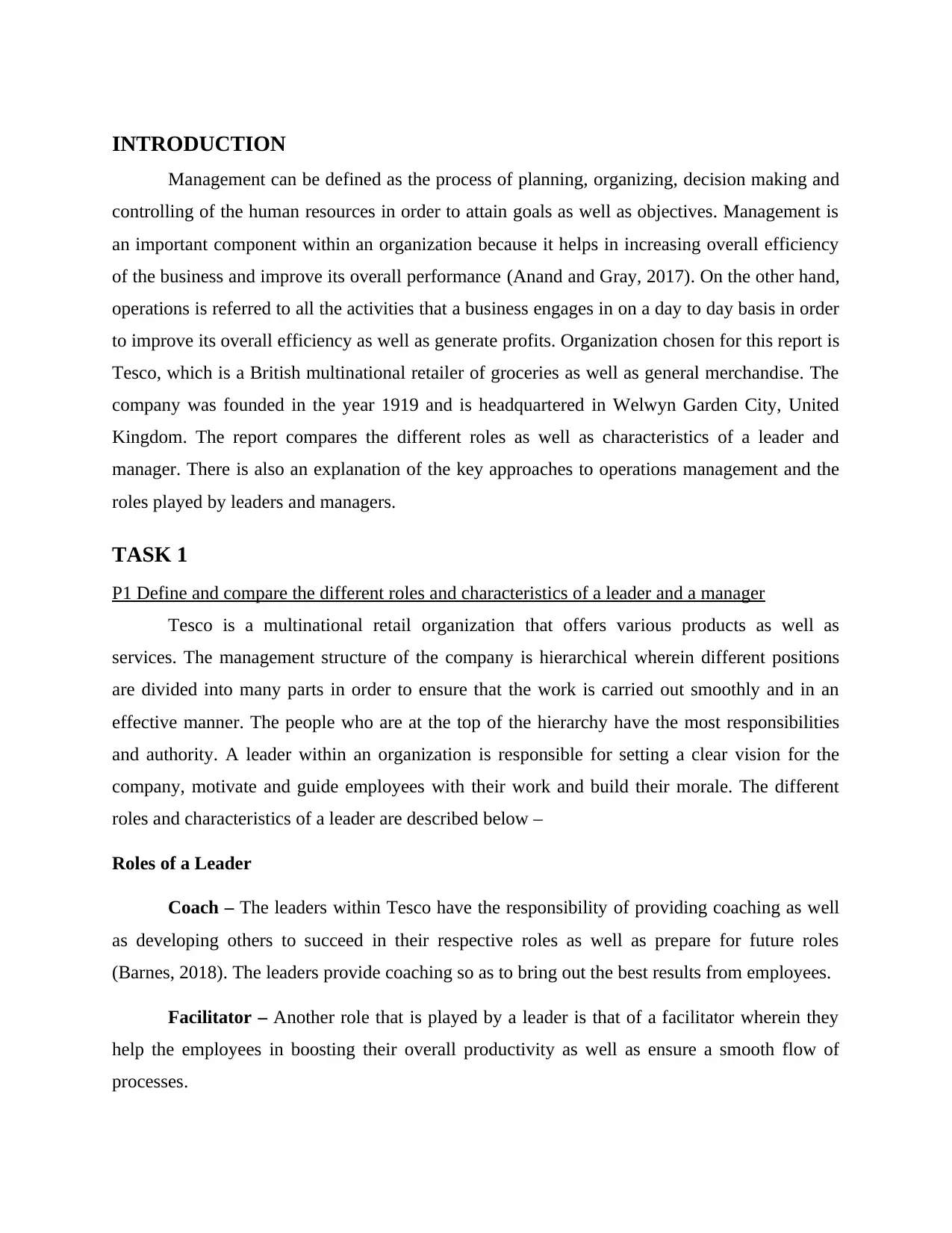
INTRODUCTION
Management can be defined as the process of planning, organizing, decision making and
controlling of the human resources in order to attain goals as well as objectives. Management is
an important component within an organization because it helps in increasing overall efficiency
of the business and improve its overall performance (Anand and Gray, 2017). On the other hand,
operations is referred to all the activities that a business engages in on a day to day basis in order
to improve its overall efficiency as well as generate profits. Organization chosen for this report is
Tesco, which is a British multinational retailer of groceries as well as general merchandise. The
company was founded in the year 1919 and is headquartered in Welwyn Garden City, United
Kingdom. The report compares the different roles as well as characteristics of a leader and
manager. There is also an explanation of the key approaches to operations management and the
roles played by leaders and managers.
TASK 1
P1 Define and compare the different roles and characteristics of a leader and a manager
Tesco is a multinational retail organization that offers various products as well as
services. The management structure of the company is hierarchical wherein different positions
are divided into many parts in order to ensure that the work is carried out smoothly and in an
effective manner. The people who are at the top of the hierarchy have the most responsibilities
and authority. A leader within an organization is responsible for setting a clear vision for the
company, motivate and guide employees with their work and build their morale. The different
roles and characteristics of a leader are described below –
Roles of a Leader
Coach – The leaders within Tesco have the responsibility of providing coaching as well
as developing others to succeed in their respective roles as well as prepare for future roles
(Barnes, 2018). The leaders provide coaching so as to bring out the best results from employees.
Facilitator – Another role that is played by a leader is that of a facilitator wherein they
help the employees in boosting their overall productivity as well as ensure a smooth flow of
processes.
Management can be defined as the process of planning, organizing, decision making and
controlling of the human resources in order to attain goals as well as objectives. Management is
an important component within an organization because it helps in increasing overall efficiency
of the business and improve its overall performance (Anand and Gray, 2017). On the other hand,
operations is referred to all the activities that a business engages in on a day to day basis in order
to improve its overall efficiency as well as generate profits. Organization chosen for this report is
Tesco, which is a British multinational retailer of groceries as well as general merchandise. The
company was founded in the year 1919 and is headquartered in Welwyn Garden City, United
Kingdom. The report compares the different roles as well as characteristics of a leader and
manager. There is also an explanation of the key approaches to operations management and the
roles played by leaders and managers.
TASK 1
P1 Define and compare the different roles and characteristics of a leader and a manager
Tesco is a multinational retail organization that offers various products as well as
services. The management structure of the company is hierarchical wherein different positions
are divided into many parts in order to ensure that the work is carried out smoothly and in an
effective manner. The people who are at the top of the hierarchy have the most responsibilities
and authority. A leader within an organization is responsible for setting a clear vision for the
company, motivate and guide employees with their work and build their morale. The different
roles and characteristics of a leader are described below –
Roles of a Leader
Coach – The leaders within Tesco have the responsibility of providing coaching as well
as developing others to succeed in their respective roles as well as prepare for future roles
(Barnes, 2018). The leaders provide coaching so as to bring out the best results from employees.
Facilitator – Another role that is played by a leader is that of a facilitator wherein they
help the employees in boosting their overall productivity as well as ensure a smooth flow of
processes.
⊘ This is a preview!⊘
Do you want full access?
Subscribe today to unlock all pages.

Trusted by 1+ million students worldwide
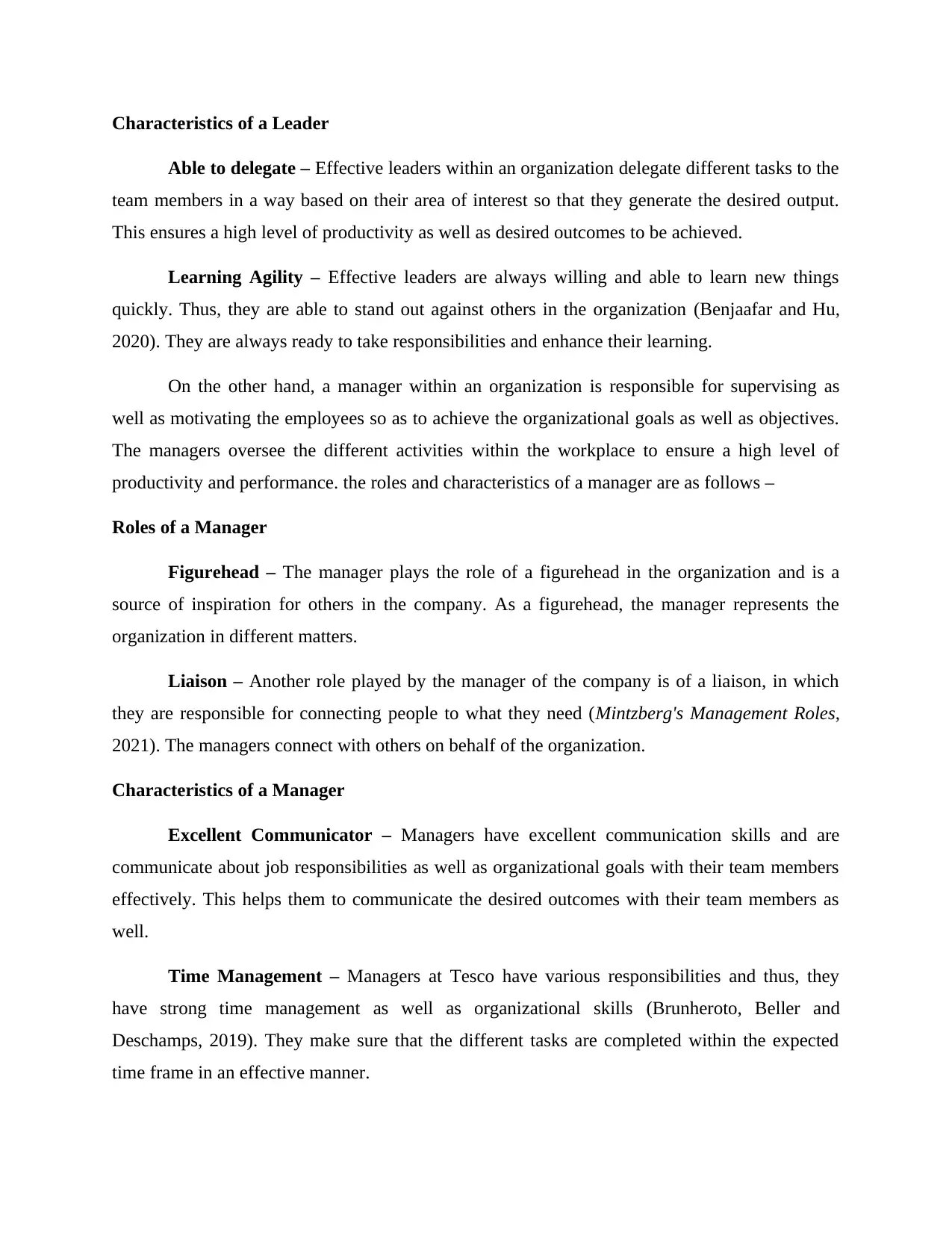
Characteristics of a Leader
Able to delegate – Effective leaders within an organization delegate different tasks to the
team members in a way based on their area of interest so that they generate the desired output.
This ensures a high level of productivity as well as desired outcomes to be achieved.
Learning Agility – Effective leaders are always willing and able to learn new things
quickly. Thus, they are able to stand out against others in the organization (Benjaafar and Hu,
2020). They are always ready to take responsibilities and enhance their learning.
On the other hand, a manager within an organization is responsible for supervising as
well as motivating the employees so as to achieve the organizational goals as well as objectives.
The managers oversee the different activities within the workplace to ensure a high level of
productivity and performance. the roles and characteristics of a manager are as follows –
Roles of a Manager
Figurehead – The manager plays the role of a figurehead in the organization and is a
source of inspiration for others in the company. As a figurehead, the manager represents the
organization in different matters.
Liaison – Another role played by the manager of the company is of a liaison, in which
they are responsible for connecting people to what they need (Mintzberg's Management Roles,
2021). The managers connect with others on behalf of the organization.
Characteristics of a Manager
Excellent Communicator – Managers have excellent communication skills and are
communicate about job responsibilities as well as organizational goals with their team members
effectively. This helps them to communicate the desired outcomes with their team members as
well.
Time Management – Managers at Tesco have various responsibilities and thus, they
have strong time management as well as organizational skills (Brunheroto, Beller and
Deschamps, 2019). They make sure that the different tasks are completed within the expected
time frame in an effective manner.
Able to delegate – Effective leaders within an organization delegate different tasks to the
team members in a way based on their area of interest so that they generate the desired output.
This ensures a high level of productivity as well as desired outcomes to be achieved.
Learning Agility – Effective leaders are always willing and able to learn new things
quickly. Thus, they are able to stand out against others in the organization (Benjaafar and Hu,
2020). They are always ready to take responsibilities and enhance their learning.
On the other hand, a manager within an organization is responsible for supervising as
well as motivating the employees so as to achieve the organizational goals as well as objectives.
The managers oversee the different activities within the workplace to ensure a high level of
productivity and performance. the roles and characteristics of a manager are as follows –
Roles of a Manager
Figurehead – The manager plays the role of a figurehead in the organization and is a
source of inspiration for others in the company. As a figurehead, the manager represents the
organization in different matters.
Liaison – Another role played by the manager of the company is of a liaison, in which
they are responsible for connecting people to what they need (Mintzberg's Management Roles,
2021). The managers connect with others on behalf of the organization.
Characteristics of a Manager
Excellent Communicator – Managers have excellent communication skills and are
communicate about job responsibilities as well as organizational goals with their team members
effectively. This helps them to communicate the desired outcomes with their team members as
well.
Time Management – Managers at Tesco have various responsibilities and thus, they
have strong time management as well as organizational skills (Brunheroto, Beller and
Deschamps, 2019). They make sure that the different tasks are completed within the expected
time frame in an effective manner.
Paraphrase This Document
Need a fresh take? Get an instant paraphrase of this document with our AI Paraphraser
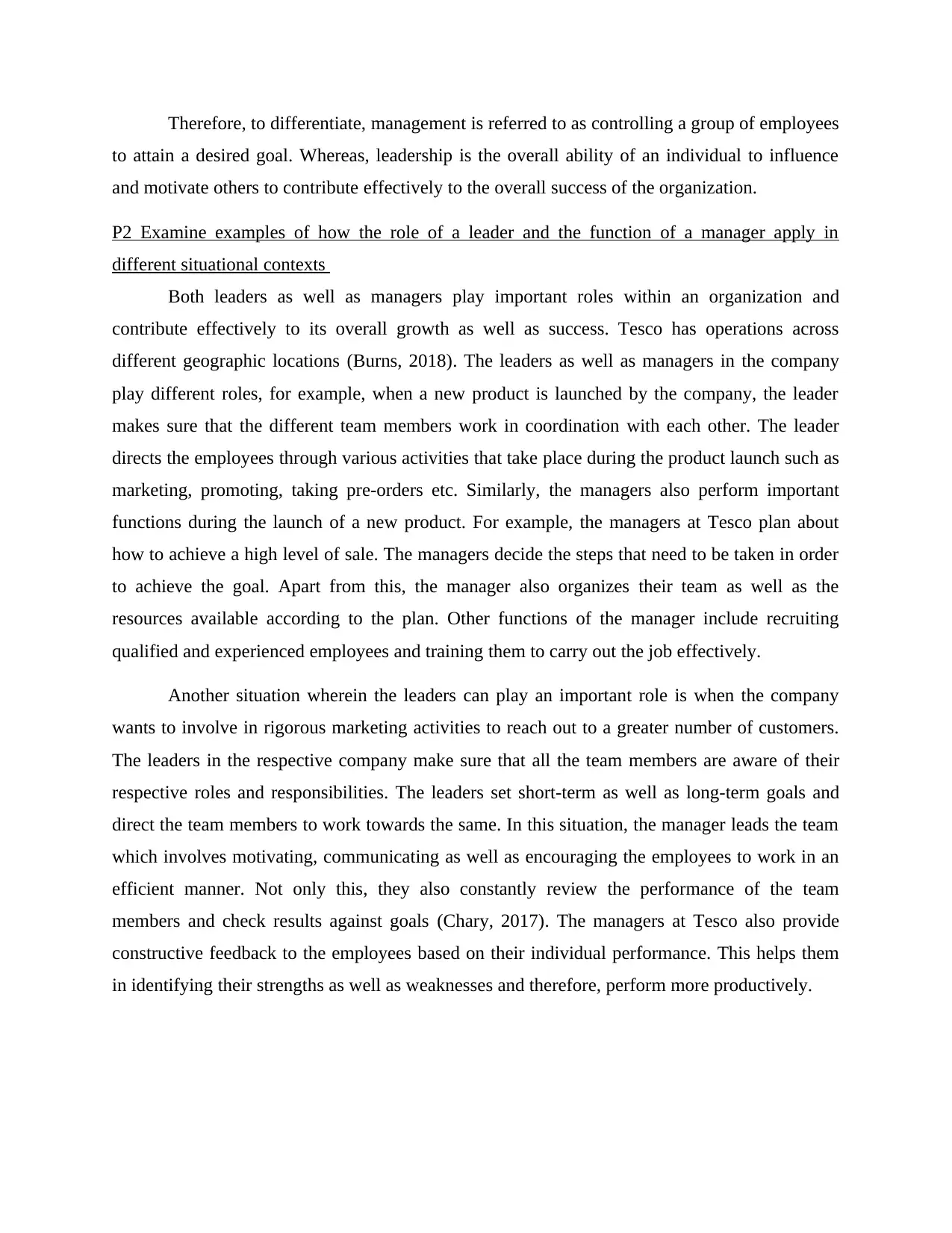
Therefore, to differentiate, management is referred to as controlling a group of employees
to attain a desired goal. Whereas, leadership is the overall ability of an individual to influence
and motivate others to contribute effectively to the overall success of the organization.
P2 Examine examples of how the role of a leader and the function of a manager apply in
different situational contexts
Both leaders as well as managers play important roles within an organization and
contribute effectively to its overall growth as well as success. Tesco has operations across
different geographic locations (Burns, 2018). The leaders as well as managers in the company
play different roles, for example, when a new product is launched by the company, the leader
makes sure that the different team members work in coordination with each other. The leader
directs the employees through various activities that take place during the product launch such as
marketing, promoting, taking pre-orders etc. Similarly, the managers also perform important
functions during the launch of a new product. For example, the managers at Tesco plan about
how to achieve a high level of sale. The managers decide the steps that need to be taken in order
to achieve the goal. Apart from this, the manager also organizes their team as well as the
resources available according to the plan. Other functions of the manager include recruiting
qualified and experienced employees and training them to carry out the job effectively.
Another situation wherein the leaders can play an important role is when the company
wants to involve in rigorous marketing activities to reach out to a greater number of customers.
The leaders in the respective company make sure that all the team members are aware of their
respective roles and responsibilities. The leaders set short-term as well as long-term goals and
direct the team members to work towards the same. In this situation, the manager leads the team
which involves motivating, communicating as well as encouraging the employees to work in an
efficient manner. Not only this, they also constantly review the performance of the team
members and check results against goals (Chary, 2017). The managers at Tesco also provide
constructive feedback to the employees based on their individual performance. This helps them
in identifying their strengths as well as weaknesses and therefore, perform more productively.
to attain a desired goal. Whereas, leadership is the overall ability of an individual to influence
and motivate others to contribute effectively to the overall success of the organization.
P2 Examine examples of how the role of a leader and the function of a manager apply in
different situational contexts
Both leaders as well as managers play important roles within an organization and
contribute effectively to its overall growth as well as success. Tesco has operations across
different geographic locations (Burns, 2018). The leaders as well as managers in the company
play different roles, for example, when a new product is launched by the company, the leader
makes sure that the different team members work in coordination with each other. The leader
directs the employees through various activities that take place during the product launch such as
marketing, promoting, taking pre-orders etc. Similarly, the managers also perform important
functions during the launch of a new product. For example, the managers at Tesco plan about
how to achieve a high level of sale. The managers decide the steps that need to be taken in order
to achieve the goal. Apart from this, the manager also organizes their team as well as the
resources available according to the plan. Other functions of the manager include recruiting
qualified and experienced employees and training them to carry out the job effectively.
Another situation wherein the leaders can play an important role is when the company
wants to involve in rigorous marketing activities to reach out to a greater number of customers.
The leaders in the respective company make sure that all the team members are aware of their
respective roles and responsibilities. The leaders set short-term as well as long-term goals and
direct the team members to work towards the same. In this situation, the manager leads the team
which involves motivating, communicating as well as encouraging the employees to work in an
efficient manner. Not only this, they also constantly review the performance of the team
members and check results against goals (Chary, 2017). The managers at Tesco also provide
constructive feedback to the employees based on their individual performance. This helps them
in identifying their strengths as well as weaknesses and therefore, perform more productively.
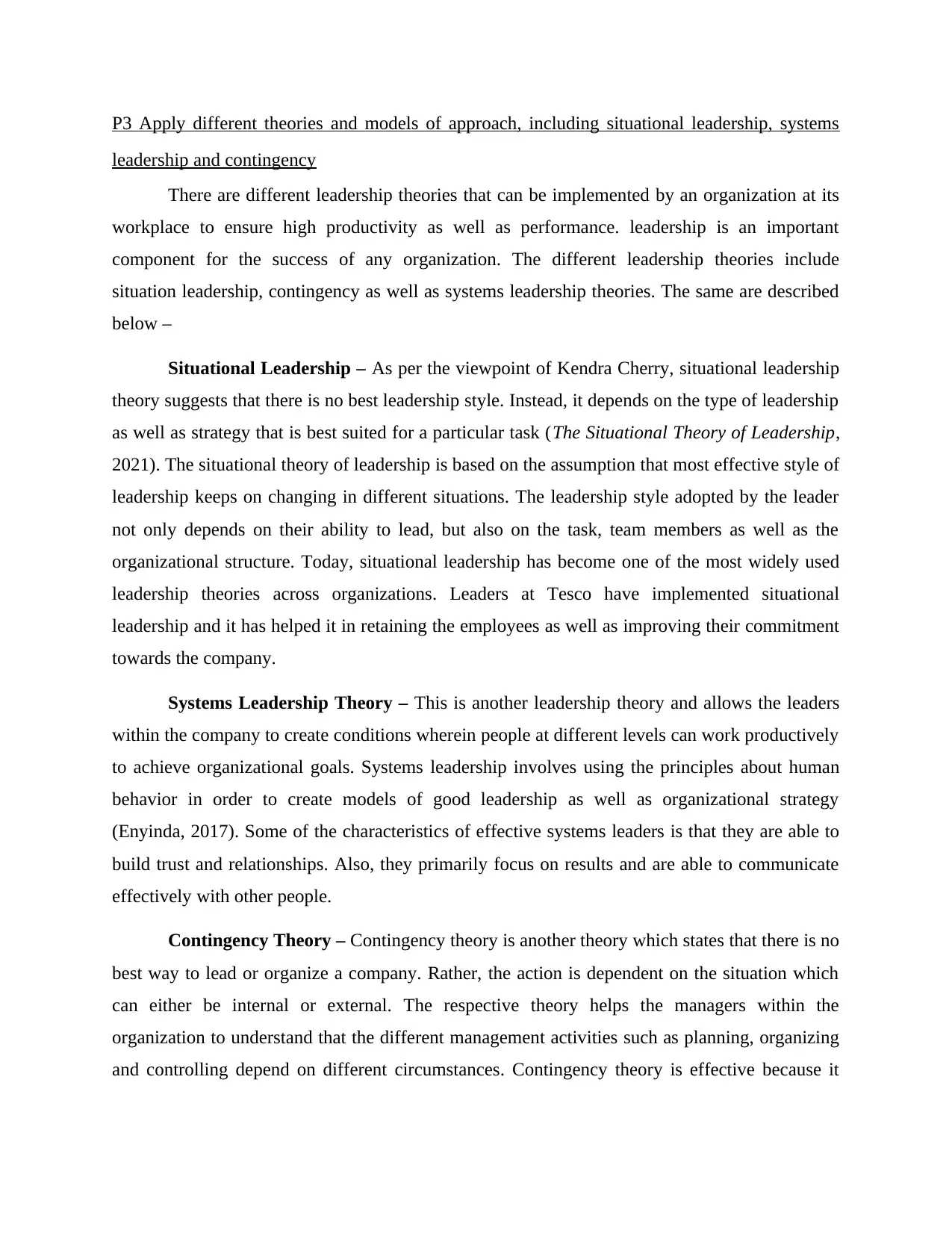
P3 Apply different theories and models of approach, including situational leadership, systems
leadership and contingency
There are different leadership theories that can be implemented by an organization at its
workplace to ensure high productivity as well as performance. leadership is an important
component for the success of any organization. The different leadership theories include
situation leadership, contingency as well as systems leadership theories. The same are described
below –
Situational Leadership – As per the viewpoint of Kendra Cherry, situational leadership
theory suggests that there is no best leadership style. Instead, it depends on the type of leadership
as well as strategy that is best suited for a particular task (The Situational Theory of Leadership,
2021). The situational theory of leadership is based on the assumption that most effective style of
leadership keeps on changing in different situations. The leadership style adopted by the leader
not only depends on their ability to lead, but also on the task, team members as well as the
organizational structure. Today, situational leadership has become one of the most widely used
leadership theories across organizations. Leaders at Tesco have implemented situational
leadership and it has helped it in retaining the employees as well as improving their commitment
towards the company.
Systems Leadership Theory – This is another leadership theory and allows the leaders
within the company to create conditions wherein people at different levels can work productively
to achieve organizational goals. Systems leadership involves using the principles about human
behavior in order to create models of good leadership as well as organizational strategy
(Enyinda, 2017). Some of the characteristics of effective systems leaders is that they are able to
build trust and relationships. Also, they primarily focus on results and are able to communicate
effectively with other people.
Contingency Theory – Contingency theory is another theory which states that there is no
best way to lead or organize a company. Rather, the action is dependent on the situation which
can either be internal or external. The respective theory helps the managers within the
organization to understand that the different management activities such as planning, organizing
and controlling depend on different circumstances. Contingency theory is effective because it
leadership and contingency
There are different leadership theories that can be implemented by an organization at its
workplace to ensure high productivity as well as performance. leadership is an important
component for the success of any organization. The different leadership theories include
situation leadership, contingency as well as systems leadership theories. The same are described
below –
Situational Leadership – As per the viewpoint of Kendra Cherry, situational leadership
theory suggests that there is no best leadership style. Instead, it depends on the type of leadership
as well as strategy that is best suited for a particular task (The Situational Theory of Leadership,
2021). The situational theory of leadership is based on the assumption that most effective style of
leadership keeps on changing in different situations. The leadership style adopted by the leader
not only depends on their ability to lead, but also on the task, team members as well as the
organizational structure. Today, situational leadership has become one of the most widely used
leadership theories across organizations. Leaders at Tesco have implemented situational
leadership and it has helped it in retaining the employees as well as improving their commitment
towards the company.
Systems Leadership Theory – This is another leadership theory and allows the leaders
within the company to create conditions wherein people at different levels can work productively
to achieve organizational goals. Systems leadership involves using the principles about human
behavior in order to create models of good leadership as well as organizational strategy
(Enyinda, 2017). Some of the characteristics of effective systems leaders is that they are able to
build trust and relationships. Also, they primarily focus on results and are able to communicate
effectively with other people.
Contingency Theory – Contingency theory is another theory which states that there is no
best way to lead or organize a company. Rather, the action is dependent on the situation which
can either be internal or external. The respective theory helps the managers within the
organization to understand that the different management activities such as planning, organizing
and controlling depend on different circumstances. Contingency theory is effective because it
⊘ This is a preview!⊘
Do you want full access?
Subscribe today to unlock all pages.

Trusted by 1+ million students worldwide
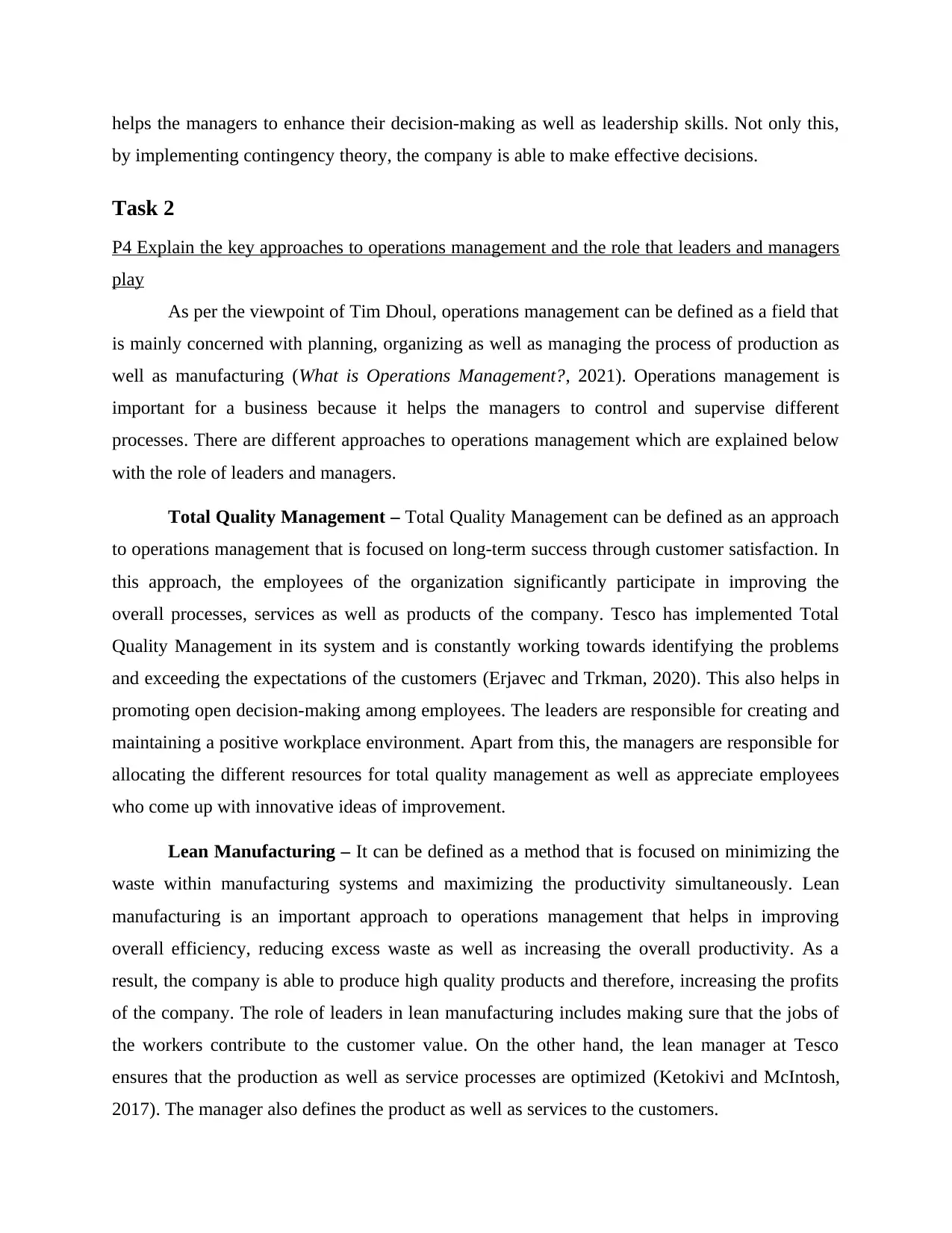
helps the managers to enhance their decision-making as well as leadership skills. Not only this,
by implementing contingency theory, the company is able to make effective decisions.
Task 2
P4 Explain the key approaches to operations management and the role that leaders and managers
play
As per the viewpoint of Tim Dhoul, operations management can be defined as a field that
is mainly concerned with planning, organizing as well as managing the process of production as
well as manufacturing (What is Operations Management?, 2021). Operations management is
important for a business because it helps the managers to control and supervise different
processes. There are different approaches to operations management which are explained below
with the role of leaders and managers.
Total Quality Management – Total Quality Management can be defined as an approach
to operations management that is focused on long-term success through customer satisfaction. In
this approach, the employees of the organization significantly participate in improving the
overall processes, services as well as products of the company. Tesco has implemented Total
Quality Management in its system and is constantly working towards identifying the problems
and exceeding the expectations of the customers (Erjavec and Trkman, 2020). This also helps in
promoting open decision-making among employees. The leaders are responsible for creating and
maintaining a positive workplace environment. Apart from this, the managers are responsible for
allocating the different resources for total quality management as well as appreciate employees
who come up with innovative ideas of improvement.
Lean Manufacturing – It can be defined as a method that is focused on minimizing the
waste within manufacturing systems and maximizing the productivity simultaneously. Lean
manufacturing is an important approach to operations management that helps in improving
overall efficiency, reducing excess waste as well as increasing the overall productivity. As a
result, the company is able to produce high quality products and therefore, increasing the profits
of the company. The role of leaders in lean manufacturing includes making sure that the jobs of
the workers contribute to the customer value. On the other hand, the lean manager at Tesco
ensures that the production as well as service processes are optimized (Ketokivi and McIntosh,
2017). The manager also defines the product as well as services to the customers.
by implementing contingency theory, the company is able to make effective decisions.
Task 2
P4 Explain the key approaches to operations management and the role that leaders and managers
play
As per the viewpoint of Tim Dhoul, operations management can be defined as a field that
is mainly concerned with planning, organizing as well as managing the process of production as
well as manufacturing (What is Operations Management?, 2021). Operations management is
important for a business because it helps the managers to control and supervise different
processes. There are different approaches to operations management which are explained below
with the role of leaders and managers.
Total Quality Management – Total Quality Management can be defined as an approach
to operations management that is focused on long-term success through customer satisfaction. In
this approach, the employees of the organization significantly participate in improving the
overall processes, services as well as products of the company. Tesco has implemented Total
Quality Management in its system and is constantly working towards identifying the problems
and exceeding the expectations of the customers (Erjavec and Trkman, 2020). This also helps in
promoting open decision-making among employees. The leaders are responsible for creating and
maintaining a positive workplace environment. Apart from this, the managers are responsible for
allocating the different resources for total quality management as well as appreciate employees
who come up with innovative ideas of improvement.
Lean Manufacturing – It can be defined as a method that is focused on minimizing the
waste within manufacturing systems and maximizing the productivity simultaneously. Lean
manufacturing is an important approach to operations management that helps in improving
overall efficiency, reducing excess waste as well as increasing the overall productivity. As a
result, the company is able to produce high quality products and therefore, increasing the profits
of the company. The role of leaders in lean manufacturing includes making sure that the jobs of
the workers contribute to the customer value. On the other hand, the lean manager at Tesco
ensures that the production as well as service processes are optimized (Ketokivi and McIntosh,
2017). The manager also defines the product as well as services to the customers.
Paraphrase This Document
Need a fresh take? Get an instant paraphrase of this document with our AI Paraphraser
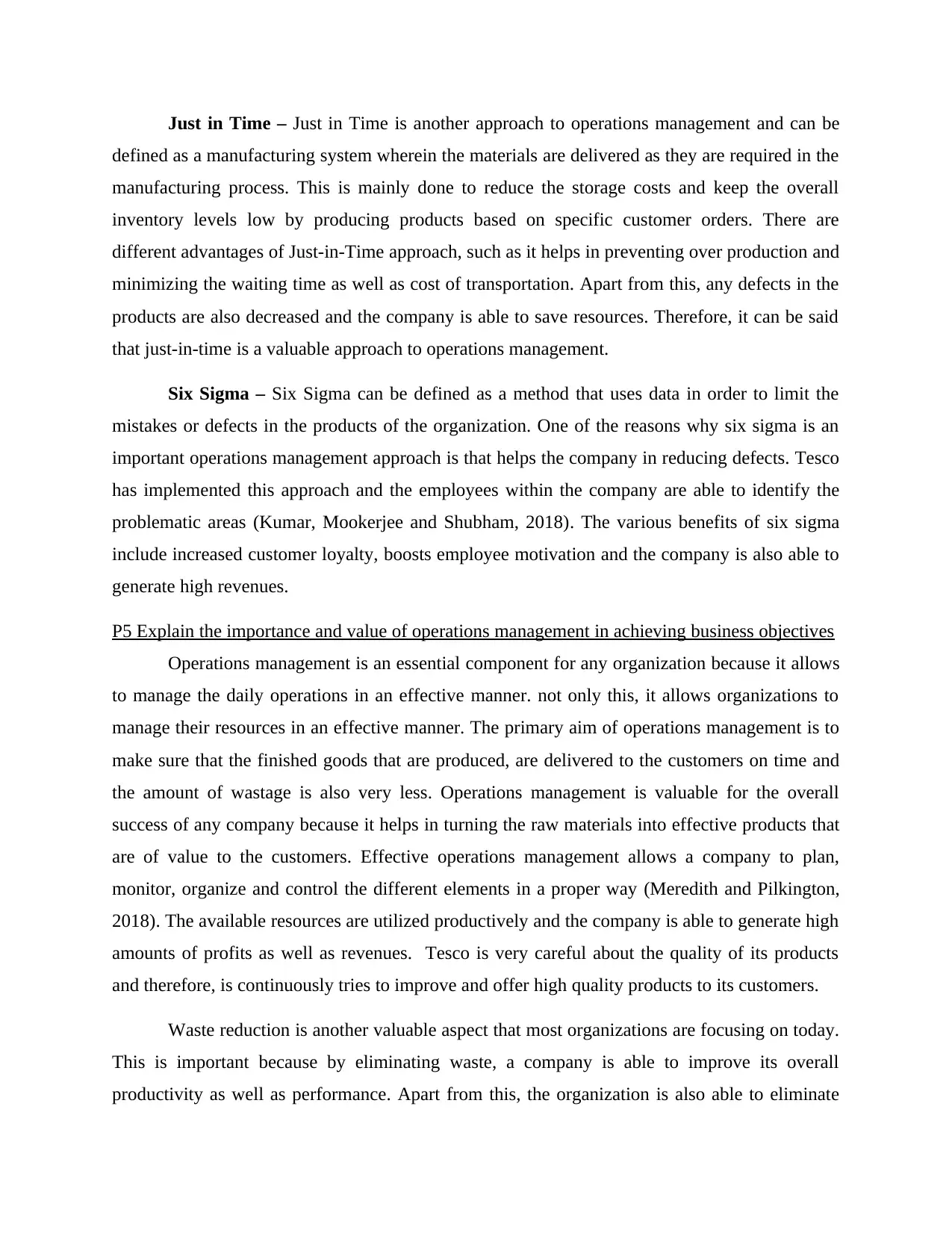
Just in Time – Just in Time is another approach to operations management and can be
defined as a manufacturing system wherein the materials are delivered as they are required in the
manufacturing process. This is mainly done to reduce the storage costs and keep the overall
inventory levels low by producing products based on specific customer orders. There are
different advantages of Just-in-Time approach, such as it helps in preventing over production and
minimizing the waiting time as well as cost of transportation. Apart from this, any defects in the
products are also decreased and the company is able to save resources. Therefore, it can be said
that just-in-time is a valuable approach to operations management.
Six Sigma – Six Sigma can be defined as a method that uses data in order to limit the
mistakes or defects in the products of the organization. One of the reasons why six sigma is an
important operations management approach is that helps the company in reducing defects. Tesco
has implemented this approach and the employees within the company are able to identify the
problematic areas (Kumar, Mookerjee and Shubham, 2018). The various benefits of six sigma
include increased customer loyalty, boosts employee motivation and the company is also able to
generate high revenues.
P5 Explain the importance and value of operations management in achieving business objectives
Operations management is an essential component for any organization because it allows
to manage the daily operations in an effective manner. not only this, it allows organizations to
manage their resources in an effective manner. The primary aim of operations management is to
make sure that the finished goods that are produced, are delivered to the customers on time and
the amount of wastage is also very less. Operations management is valuable for the overall
success of any company because it helps in turning the raw materials into effective products that
are of value to the customers. Effective operations management allows a company to plan,
monitor, organize and control the different elements in a proper way (Meredith and Pilkington,
2018). The available resources are utilized productively and the company is able to generate high
amounts of profits as well as revenues. Tesco is very careful about the quality of its products
and therefore, is continuously tries to improve and offer high quality products to its customers.
Waste reduction is another valuable aspect that most organizations are focusing on today.
This is important because by eliminating waste, a company is able to improve its overall
productivity as well as performance. Apart from this, the organization is also able to eliminate
defined as a manufacturing system wherein the materials are delivered as they are required in the
manufacturing process. This is mainly done to reduce the storage costs and keep the overall
inventory levels low by producing products based on specific customer orders. There are
different advantages of Just-in-Time approach, such as it helps in preventing over production and
minimizing the waiting time as well as cost of transportation. Apart from this, any defects in the
products are also decreased and the company is able to save resources. Therefore, it can be said
that just-in-time is a valuable approach to operations management.
Six Sigma – Six Sigma can be defined as a method that uses data in order to limit the
mistakes or defects in the products of the organization. One of the reasons why six sigma is an
important operations management approach is that helps the company in reducing defects. Tesco
has implemented this approach and the employees within the company are able to identify the
problematic areas (Kumar, Mookerjee and Shubham, 2018). The various benefits of six sigma
include increased customer loyalty, boosts employee motivation and the company is also able to
generate high revenues.
P5 Explain the importance and value of operations management in achieving business objectives
Operations management is an essential component for any organization because it allows
to manage the daily operations in an effective manner. not only this, it allows organizations to
manage their resources in an effective manner. The primary aim of operations management is to
make sure that the finished goods that are produced, are delivered to the customers on time and
the amount of wastage is also very less. Operations management is valuable for the overall
success of any company because it helps in turning the raw materials into effective products that
are of value to the customers. Effective operations management allows a company to plan,
monitor, organize and control the different elements in a proper way (Meredith and Pilkington,
2018). The available resources are utilized productively and the company is able to generate high
amounts of profits as well as revenues. Tesco is very careful about the quality of its products
and therefore, is continuously tries to improve and offer high quality products to its customers.
Waste reduction is another valuable aspect that most organizations are focusing on today.
This is important because by eliminating waste, a company is able to improve its overall
productivity as well as performance. Apart from this, the organization is also able to eliminate
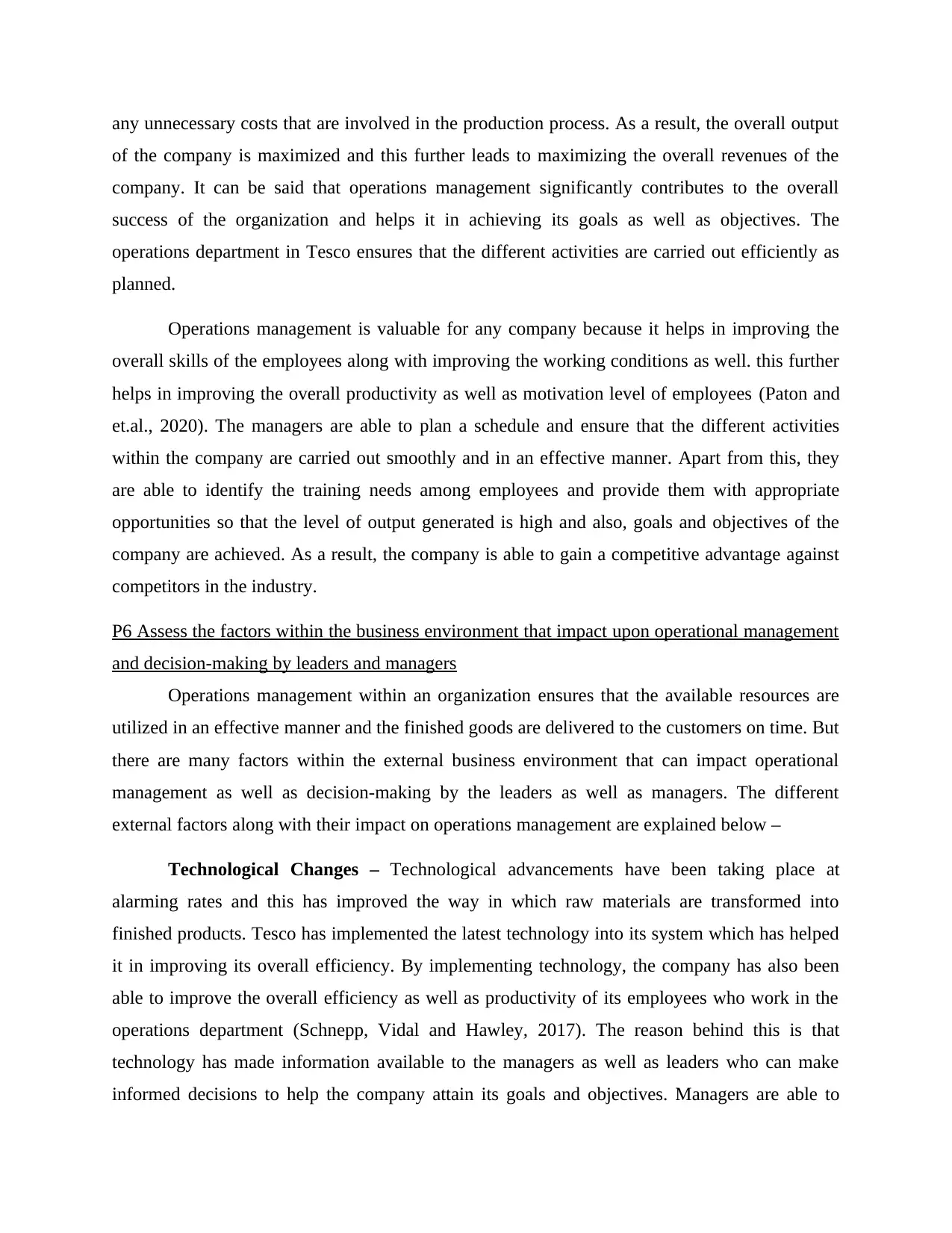
any unnecessary costs that are involved in the production process. As a result, the overall output
of the company is maximized and this further leads to maximizing the overall revenues of the
company. It can be said that operations management significantly contributes to the overall
success of the organization and helps it in achieving its goals as well as objectives. The
operations department in Tesco ensures that the different activities are carried out efficiently as
planned.
Operations management is valuable for any company because it helps in improving the
overall skills of the employees along with improving the working conditions as well. this further
helps in improving the overall productivity as well as motivation level of employees (Paton and
et.al., 2020). The managers are able to plan a schedule and ensure that the different activities
within the company are carried out smoothly and in an effective manner. Apart from this, they
are able to identify the training needs among employees and provide them with appropriate
opportunities so that the level of output generated is high and also, goals and objectives of the
company are achieved. As a result, the company is able to gain a competitive advantage against
competitors in the industry.
P6 Assess the factors within the business environment that impact upon operational management
and decision-making by leaders and managers
Operations management within an organization ensures that the available resources are
utilized in an effective manner and the finished goods are delivered to the customers on time. But
there are many factors within the external business environment that can impact operational
management as well as decision-making by the leaders as well as managers. The different
external factors along with their impact on operations management are explained below –
Technological Changes – Technological advancements have been taking place at
alarming rates and this has improved the way in which raw materials are transformed into
finished products. Tesco has implemented the latest technology into its system which has helped
it in improving its overall efficiency. By implementing technology, the company has also been
able to improve the overall efficiency as well as productivity of its employees who work in the
operations department (Schnepp, Vidal and Hawley, 2017). The reason behind this is that
technology has made information available to the managers as well as leaders who can make
informed decisions to help the company attain its goals and objectives. Managers are able to
of the company is maximized and this further leads to maximizing the overall revenues of the
company. It can be said that operations management significantly contributes to the overall
success of the organization and helps it in achieving its goals as well as objectives. The
operations department in Tesco ensures that the different activities are carried out efficiently as
planned.
Operations management is valuable for any company because it helps in improving the
overall skills of the employees along with improving the working conditions as well. this further
helps in improving the overall productivity as well as motivation level of employees (Paton and
et.al., 2020). The managers are able to plan a schedule and ensure that the different activities
within the company are carried out smoothly and in an effective manner. Apart from this, they
are able to identify the training needs among employees and provide them with appropriate
opportunities so that the level of output generated is high and also, goals and objectives of the
company are achieved. As a result, the company is able to gain a competitive advantage against
competitors in the industry.
P6 Assess the factors within the business environment that impact upon operational management
and decision-making by leaders and managers
Operations management within an organization ensures that the available resources are
utilized in an effective manner and the finished goods are delivered to the customers on time. But
there are many factors within the external business environment that can impact operational
management as well as decision-making by the leaders as well as managers. The different
external factors along with their impact on operations management are explained below –
Technological Changes – Technological advancements have been taking place at
alarming rates and this has improved the way in which raw materials are transformed into
finished products. Tesco has implemented the latest technology into its system which has helped
it in improving its overall efficiency. By implementing technology, the company has also been
able to improve the overall efficiency as well as productivity of its employees who work in the
operations department (Schnepp, Vidal and Hawley, 2017). The reason behind this is that
technology has made information available to the managers as well as leaders who can make
informed decisions to help the company attain its goals and objectives. Managers are able to
⊘ This is a preview!⊘
Do you want full access?
Subscribe today to unlock all pages.

Trusted by 1+ million students worldwide
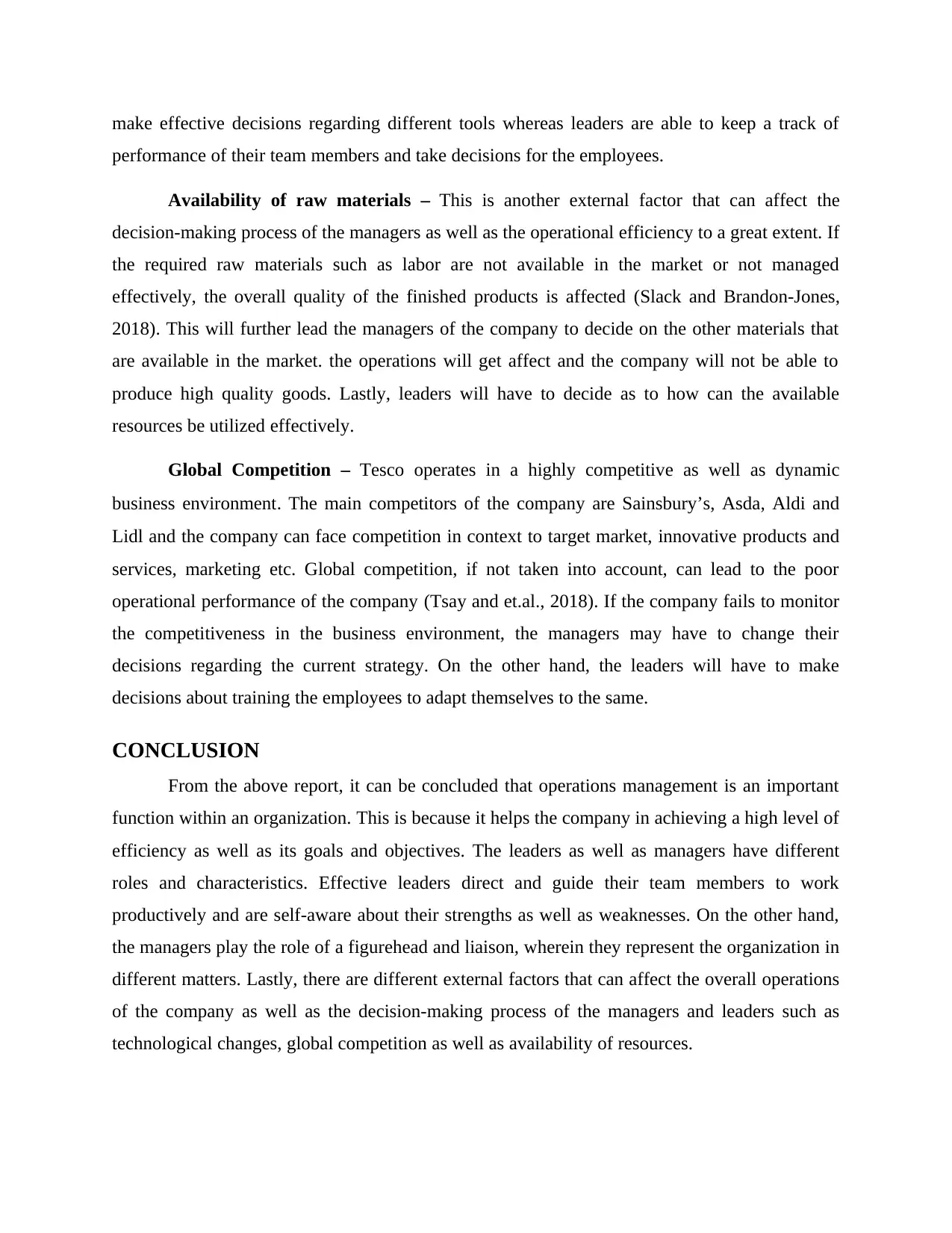
make effective decisions regarding different tools whereas leaders are able to keep a track of
performance of their team members and take decisions for the employees.
Availability of raw materials – This is another external factor that can affect the
decision-making process of the managers as well as the operational efficiency to a great extent. If
the required raw materials such as labor are not available in the market or not managed
effectively, the overall quality of the finished products is affected (Slack and Brandon-Jones,
2018). This will further lead the managers of the company to decide on the other materials that
are available in the market. the operations will get affect and the company will not be able to
produce high quality goods. Lastly, leaders will have to decide as to how can the available
resources be utilized effectively.
Global Competition – Tesco operates in a highly competitive as well as dynamic
business environment. The main competitors of the company are Sainsbury’s, Asda, Aldi and
Lidl and the company can face competition in context to target market, innovative products and
services, marketing etc. Global competition, if not taken into account, can lead to the poor
operational performance of the company (Tsay and et.al., 2018). If the company fails to monitor
the competitiveness in the business environment, the managers may have to change their
decisions regarding the current strategy. On the other hand, the leaders will have to make
decisions about training the employees to adapt themselves to the same.
CONCLUSION
From the above report, it can be concluded that operations management is an important
function within an organization. This is because it helps the company in achieving a high level of
efficiency as well as its goals and objectives. The leaders as well as managers have different
roles and characteristics. Effective leaders direct and guide their team members to work
productively and are self-aware about their strengths as well as weaknesses. On the other hand,
the managers play the role of a figurehead and liaison, wherein they represent the organization in
different matters. Lastly, there are different external factors that can affect the overall operations
of the company as well as the decision-making process of the managers and leaders such as
technological changes, global competition as well as availability of resources.
performance of their team members and take decisions for the employees.
Availability of raw materials – This is another external factor that can affect the
decision-making process of the managers as well as the operational efficiency to a great extent. If
the required raw materials such as labor are not available in the market or not managed
effectively, the overall quality of the finished products is affected (Slack and Brandon-Jones,
2018). This will further lead the managers of the company to decide on the other materials that
are available in the market. the operations will get affect and the company will not be able to
produce high quality goods. Lastly, leaders will have to decide as to how can the available
resources be utilized effectively.
Global Competition – Tesco operates in a highly competitive as well as dynamic
business environment. The main competitors of the company are Sainsbury’s, Asda, Aldi and
Lidl and the company can face competition in context to target market, innovative products and
services, marketing etc. Global competition, if not taken into account, can lead to the poor
operational performance of the company (Tsay and et.al., 2018). If the company fails to monitor
the competitiveness in the business environment, the managers may have to change their
decisions regarding the current strategy. On the other hand, the leaders will have to make
decisions about training the employees to adapt themselves to the same.
CONCLUSION
From the above report, it can be concluded that operations management is an important
function within an organization. This is because it helps the company in achieving a high level of
efficiency as well as its goals and objectives. The leaders as well as managers have different
roles and characteristics. Effective leaders direct and guide their team members to work
productively and are self-aware about their strengths as well as weaknesses. On the other hand,
the managers play the role of a figurehead and liaison, wherein they represent the organization in
different matters. Lastly, there are different external factors that can affect the overall operations
of the company as well as the decision-making process of the managers and leaders such as
technological changes, global competition as well as availability of resources.
Paraphrase This Document
Need a fresh take? Get an instant paraphrase of this document with our AI Paraphraser
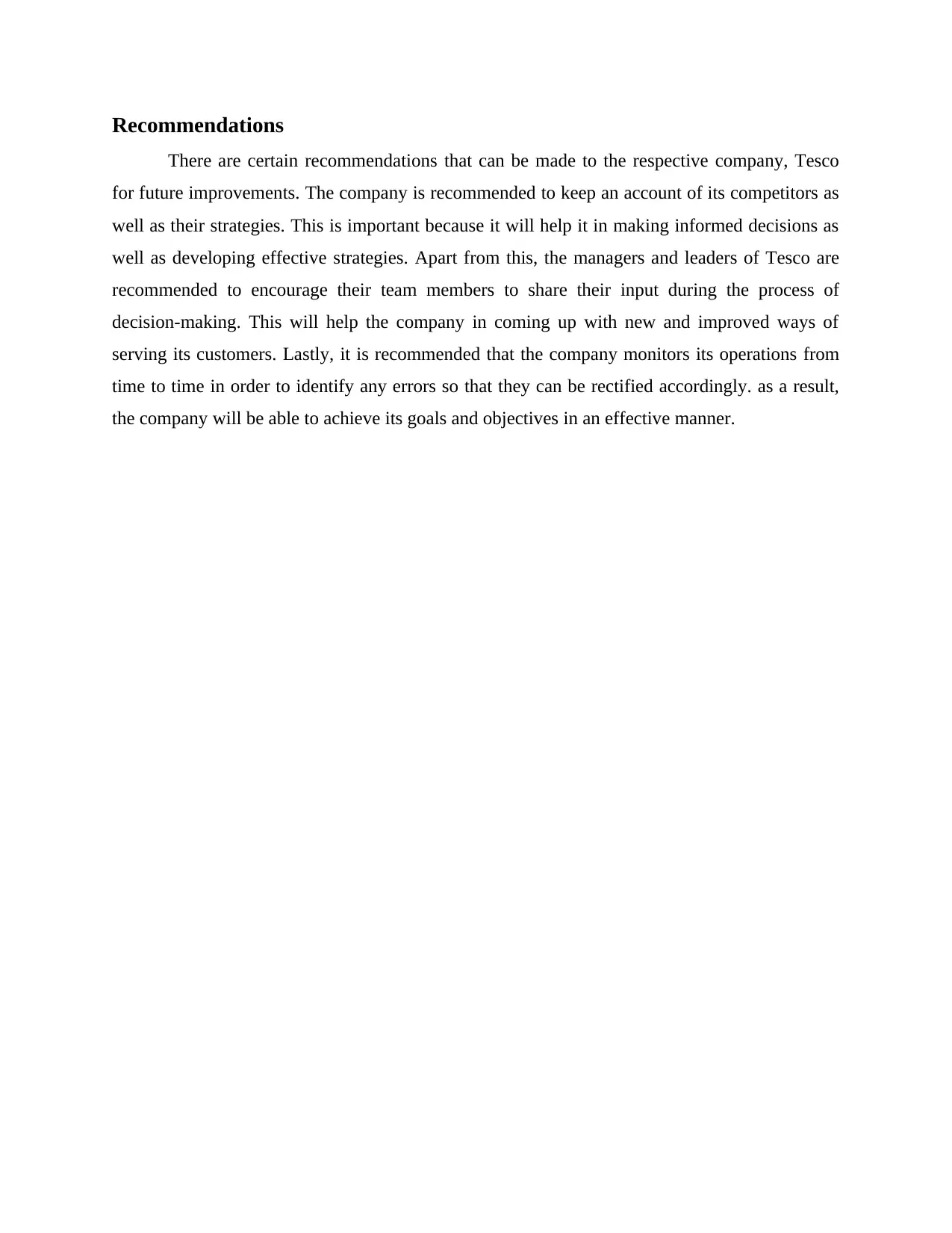
Recommendations
There are certain recommendations that can be made to the respective company, Tesco
for future improvements. The company is recommended to keep an account of its competitors as
well as their strategies. This is important because it will help it in making informed decisions as
well as developing effective strategies. Apart from this, the managers and leaders of Tesco are
recommended to encourage their team members to share their input during the process of
decision-making. This will help the company in coming up with new and improved ways of
serving its customers. Lastly, it is recommended that the company monitors its operations from
time to time in order to identify any errors so that they can be rectified accordingly. as a result,
the company will be able to achieve its goals and objectives in an effective manner.
There are certain recommendations that can be made to the respective company, Tesco
for future improvements. The company is recommended to keep an account of its competitors as
well as their strategies. This is important because it will help it in making informed decisions as
well as developing effective strategies. Apart from this, the managers and leaders of Tesco are
recommended to encourage their team members to share their input during the process of
decision-making. This will help the company in coming up with new and improved ways of
serving its customers. Lastly, it is recommended that the company monitors its operations from
time to time in order to identify any errors so that they can be rectified accordingly. as a result,
the company will be able to achieve its goals and objectives in an effective manner.
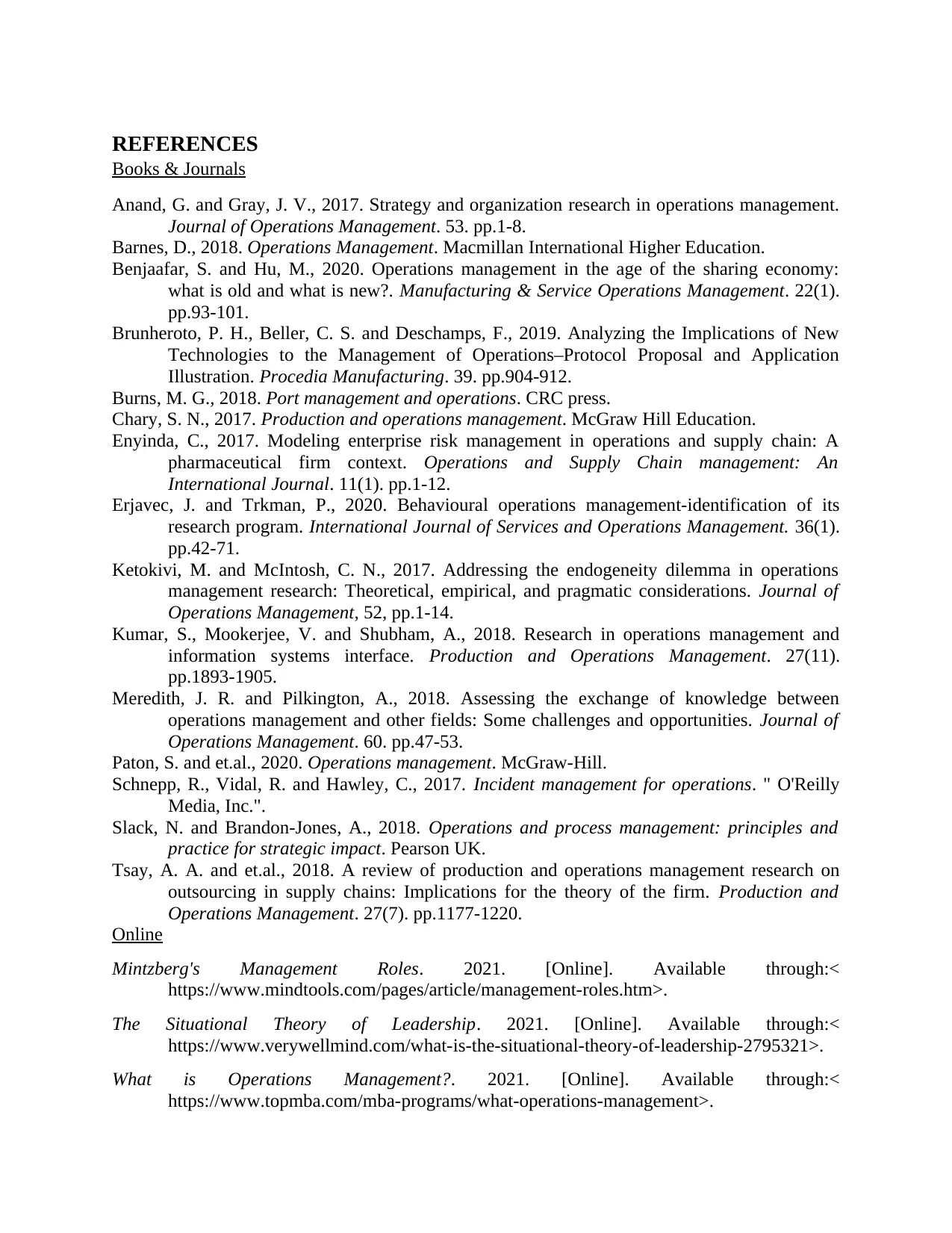
REFERENCES
Books & Journals
Anand, G. and Gray, J. V., 2017. Strategy and organization research in operations management.
Journal of Operations Management. 53. pp.1-8.
Barnes, D., 2018. Operations Management. Macmillan International Higher Education.
Benjaafar, S. and Hu, M., 2020. Operations management in the age of the sharing economy:
what is old and what is new?. Manufacturing & Service Operations Management. 22(1).
pp.93-101.
Brunheroto, P. H., Beller, C. S. and Deschamps, F., 2019. Analyzing the Implications of New
Technologies to the Management of Operations–Protocol Proposal and Application
Illustration. Procedia Manufacturing. 39. pp.904-912.
Burns, M. G., 2018. Port management and operations. CRC press.
Chary, S. N., 2017. Production and operations management. McGraw Hill Education.
Enyinda, C., 2017. Modeling enterprise risk management in operations and supply chain: A
pharmaceutical firm context. Operations and Supply Chain management: An
International Journal. 11(1). pp.1-12.
Erjavec, J. and Trkman, P., 2020. Behavioural operations management-identification of its
research program. International Journal of Services and Operations Management. 36(1).
pp.42-71.
Ketokivi, M. and McIntosh, C. N., 2017. Addressing the endogeneity dilemma in operations
management research: Theoretical, empirical, and pragmatic considerations. Journal of
Operations Management, 52, pp.1-14.
Kumar, S., Mookerjee, V. and Shubham, A., 2018. Research in operations management and
information systems interface. Production and Operations Management. 27(11).
pp.1893-1905.
Meredith, J. R. and Pilkington, A., 2018. Assessing the exchange of knowledge between
operations management and other fields: Some challenges and opportunities. Journal of
Operations Management. 60. pp.47-53.
Paton, S. and et.al., 2020. Operations management. McGraw-Hill.
Schnepp, R., Vidal, R. and Hawley, C., 2017. Incident management for operations. " O'Reilly
Media, Inc.".
Slack, N. and Brandon-Jones, A., 2018. Operations and process management: principles and
practice for strategic impact. Pearson UK.
Tsay, A. A. and et.al., 2018. A review of production and operations management research on
outsourcing in supply chains: Implications for the theory of the firm. Production and
Operations Management. 27(7). pp.1177-1220.
Online
Mintzberg's Management Roles. 2021. [Online]. Available through:<
https://www.mindtools.com/pages/article/management-roles.htm>.
The Situational Theory of Leadership. 2021. [Online]. Available through:<
https://www.verywellmind.com/what-is-the-situational-theory-of-leadership-2795321>.
What is Operations Management?. 2021. [Online]. Available through:<
https://www.topmba.com/mba-programs/what-operations-management>.
Books & Journals
Anand, G. and Gray, J. V., 2017. Strategy and organization research in operations management.
Journal of Operations Management. 53. pp.1-8.
Barnes, D., 2018. Operations Management. Macmillan International Higher Education.
Benjaafar, S. and Hu, M., 2020. Operations management in the age of the sharing economy:
what is old and what is new?. Manufacturing & Service Operations Management. 22(1).
pp.93-101.
Brunheroto, P. H., Beller, C. S. and Deschamps, F., 2019. Analyzing the Implications of New
Technologies to the Management of Operations–Protocol Proposal and Application
Illustration. Procedia Manufacturing. 39. pp.904-912.
Burns, M. G., 2018. Port management and operations. CRC press.
Chary, S. N., 2017. Production and operations management. McGraw Hill Education.
Enyinda, C., 2017. Modeling enterprise risk management in operations and supply chain: A
pharmaceutical firm context. Operations and Supply Chain management: An
International Journal. 11(1). pp.1-12.
Erjavec, J. and Trkman, P., 2020. Behavioural operations management-identification of its
research program. International Journal of Services and Operations Management. 36(1).
pp.42-71.
Ketokivi, M. and McIntosh, C. N., 2017. Addressing the endogeneity dilemma in operations
management research: Theoretical, empirical, and pragmatic considerations. Journal of
Operations Management, 52, pp.1-14.
Kumar, S., Mookerjee, V. and Shubham, A., 2018. Research in operations management and
information systems interface. Production and Operations Management. 27(11).
pp.1893-1905.
Meredith, J. R. and Pilkington, A., 2018. Assessing the exchange of knowledge between
operations management and other fields: Some challenges and opportunities. Journal of
Operations Management. 60. pp.47-53.
Paton, S. and et.al., 2020. Operations management. McGraw-Hill.
Schnepp, R., Vidal, R. and Hawley, C., 2017. Incident management for operations. " O'Reilly
Media, Inc.".
Slack, N. and Brandon-Jones, A., 2018. Operations and process management: principles and
practice for strategic impact. Pearson UK.
Tsay, A. A. and et.al., 2018. A review of production and operations management research on
outsourcing in supply chains: Implications for the theory of the firm. Production and
Operations Management. 27(7). pp.1177-1220.
Online
Mintzberg's Management Roles. 2021. [Online]. Available through:<
https://www.mindtools.com/pages/article/management-roles.htm>.
The Situational Theory of Leadership. 2021. [Online]. Available through:<
https://www.verywellmind.com/what-is-the-situational-theory-of-leadership-2795321>.
What is Operations Management?. 2021. [Online]. Available through:<
https://www.topmba.com/mba-programs/what-operations-management>.
⊘ This is a preview!⊘
Do you want full access?
Subscribe today to unlock all pages.

Trusted by 1+ million students worldwide
1 out of 12
Related Documents
Your All-in-One AI-Powered Toolkit for Academic Success.
+13062052269
info@desklib.com
Available 24*7 on WhatsApp / Email
![[object Object]](/_next/static/media/star-bottom.7253800d.svg)
Unlock your academic potential
Copyright © 2020–2025 A2Z Services. All Rights Reserved. Developed and managed by ZUCOL.





